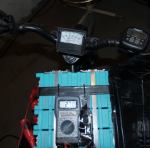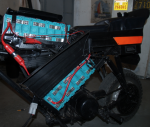Re: Hey digital console users don't forget your UPS
This post relates to my brief testing of the Cyberpower CP850PFCLCD UPS
I don't have a scope handy that will do 120V so judging the quality of the sine wave output will have to wait (or be checked by someone else)
OK, so I got frankenstein back up and running. and I'm glad I fixed it up because the cable was just as bad at the inlet as it was in the plug. the whole thing was a big fire hazard.
Some very interesting results:
Where to begin?
The AVR circuitry does nothing for overvoltage.. so if I run the input voltage right up to the setpoint the output voltage tracks it all the way until it switches to battery, and then the output drops to 120V until the voltage comes back below the setpoint. but I don't think that's usually the problem we're facing, and the max voltage can be set to whatever you feel is safe.
What the AVR circuitry DOES do is that is boosts the voltage if the input drops below 100V and stays engaged until the input voltage reaches the low setpoint at which the battery kicks in.
That all sounds cool but here's the gotcha, AVR is either on or off. and when it is on it provides a 10-12V boost.
so as I'm lowering the input voltage the output goes down slowly, then snaps UP by 10V then down slowly again until battery and then snaps UP again straight to 120.
I don't know how much that would matter to our equipment, but this is NOT a voltage regulator as we know the term.
Thinking about it more, I guess this is what every typical offline UPS does. you get to the setpoint and the output voltage jumps up to normal when it switches to battery, so maybe that's not a big deal?
if not, then there may indeed be a place for these units.. in cases where a generator feed is continually causing your UPS to dip in and out of battery power this unit could extend that window by 10V
For example, the minimum setpoint is 78V. so if you set it that low your UPS wouldn't switch over to battery power until 78V but your equipment would never see less than 88V.
If this thing reacts as quick as it's supposed to (4ms according to them) then it could effectively absorb brown-outs caused by big bass hits. your voltage would be jumping up instead of dipping, but maybe that's ok?
I'm sure some of these conclusions could fall apart real quick in a real-world situation, but that's what me, frankenstein, my Fluke 87, and a 40W light bulb were able to discern.
if anyone wants me to try anything else I'm here all week..
Jason
after doing this I looked at the Tripp-Lite unit mentioned by Othmane (the SMART1200LCD) and it mentions right in the specs that its AVR (they use the same term) circuits "regulate brownouts and overvoltages from 75V to 147V back to usable levels without using battery power" so it appears they they handle the overvoltage condition as well.
also of note is that I went looking for smaller versions of this UPS and the SMART1000LCD only claims to regulate brownouts without using battery power. so perhaps there is a size cutoff where both brands do over as well as under voltage regulating.
I'd be very curious to know whether one does it more gracefully than the other though!
This post relates to my brief testing of the Cyberpower CP850PFCLCD UPS
I don't have a scope handy that will do 120V so judging the quality of the sine wave output will have to wait (or be checked by someone else)
OK, so I got frankenstein back up and running. and I'm glad I fixed it up because the cable was just as bad at the inlet as it was in the plug. the whole thing was a big fire hazard.
Some very interesting results:
Where to begin?
The AVR circuitry does nothing for overvoltage.. so if I run the input voltage right up to the setpoint the output voltage tracks it all the way until it switches to battery, and then the output drops to 120V until the voltage comes back below the setpoint. but I don't think that's usually the problem we're facing, and the max voltage can be set to whatever you feel is safe.
What the AVR circuitry DOES do is that is boosts the voltage if the input drops below 100V and stays engaged until the input voltage reaches the low setpoint at which the battery kicks in.
That all sounds cool but here's the gotcha, AVR is either on or off. and when it is on it provides a 10-12V boost.
so as I'm lowering the input voltage the output goes down slowly, then snaps UP by 10V then down slowly again until battery and then snaps UP again straight to 120.
I don't know how much that would matter to our equipment, but this is NOT a voltage regulator as we know the term.
Thinking about it more, I guess this is what every typical offline UPS does. you get to the setpoint and the output voltage jumps up to normal when it switches to battery, so maybe that's not a big deal?
if not, then there may indeed be a place for these units.. in cases where a generator feed is continually causing your UPS to dip in and out of battery power this unit could extend that window by 10V
For example, the minimum setpoint is 78V. so if you set it that low your UPS wouldn't switch over to battery power until 78V but your equipment would never see less than 88V.
If this thing reacts as quick as it's supposed to (4ms according to them) then it could effectively absorb brown-outs caused by big bass hits. your voltage would be jumping up instead of dipping, but maybe that's ok?
I'm sure some of these conclusions could fall apart real quick in a real-world situation, but that's what me, frankenstein, my Fluke 87, and a 40W light bulb were able to discern.
if anyone wants me to try anything else I'm here all week..
Jason
after doing this I looked at the Tripp-Lite unit mentioned by Othmane (the SMART1200LCD) and it mentions right in the specs that its AVR (they use the same term) circuits "regulate brownouts and overvoltages from 75V to 147V back to usable levels without using battery power" so it appears they they handle the overvoltage condition as well.
also of note is that I went looking for smaller versions of this UPS and the SMART1000LCD only claims to regulate brownouts without using battery power. so perhaps there is a size cutoff where both brands do over as well as under voltage regulating.
I'd be very curious to know whether one does it more gracefully than the other though!
Last edited:


